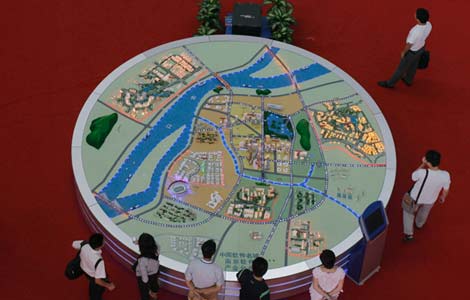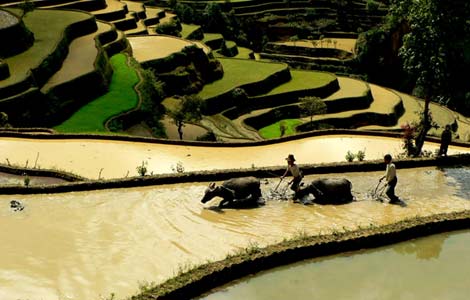Engineers develop 'fish lane' for dam in Jiangxi
Updated: 2013-06-24 07:13
By Hou Liqiang in Xiajiang, Jiangxi (China Daily)
|
||||||||
Engineers working on the Xiajiang Hydropower Project have designed a special "fish lane" to prevent migration patterns being affected by a dam on the Ganjiang River.
According to the plan, a 3-meter-deep open-air zigzag channel stretching 815 meters will be built into the dam, 155 km from Nanchang, the capital of Jiangxi province.
The zigzag design will reduce the gradient and water velocity, making it easier for the fish to swim upstream, said Liu Zubin, head of technology for the Xiajiang Hydropower Project team.
Man-made pools will also provide fish with places to rest along the channel, he said.
As the entrance to the channel is only 3 meters wide - the dam spans 874 meters - engineers have also included a guiding system that covers more than 100 meters.
"Different fish have different habits," Liu explained. "The system will allow us to adjust water levels and flow velocity as needed to attract various fish and guide them through.
Chang Jianbo, director of the Institute of Hydroecology under the Ministry of Water Resources and Chinese Academy of Sciences, which consulted on the project, supported the introduction of a fish lane. However, he believed the deficiency of the fish lane lies in the fact that its entrance cannot be adjusted on different hydrological conditions.
The deficiency could only be made up by the guiding system, he said.
As well as the lane and guiding systems, a breeding station will be built and several million larvae will be released upstream and downstream to ensure the survival and quality of species.
The Xiajiang Hydro Project is on the narrowest part of the Guangjiang River. Work started in September 2009 and is scheduled to finish in August 2015. The fish lane is already under construction, Liu said.
According to Yao Yichen, deputy director of the construction headquarters, the project will enable Nanchang to prevent flooding.
The project will also generate 1,142 million kilowatt hours of electricity a year and offer passage for ships with a displacement of 1,000 metric tons.
houliqiang@chinadaily.com.cn
(China Daily USA 06/24/2013 page7)
Most Viewed
Editor's Picks

|

|

|

|

|

|
Today's Top News
China shares deepen downward spiral
Snowden exposes more US hacking, then flies
Xi vows bigger stride in space exploration
Mandela's condition critical
Suspect in shooting spree detained
Mountaineers killed in Pakistan
Foreign firms eye new 'opening-up'
Project halted due to bird nests
US Weekly

|

|















